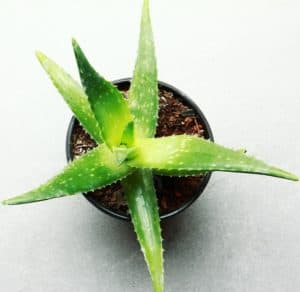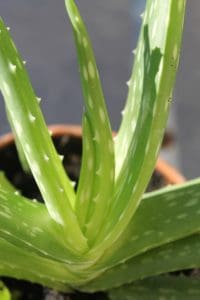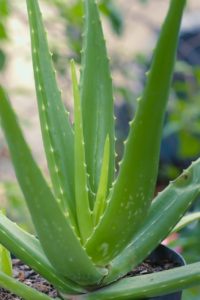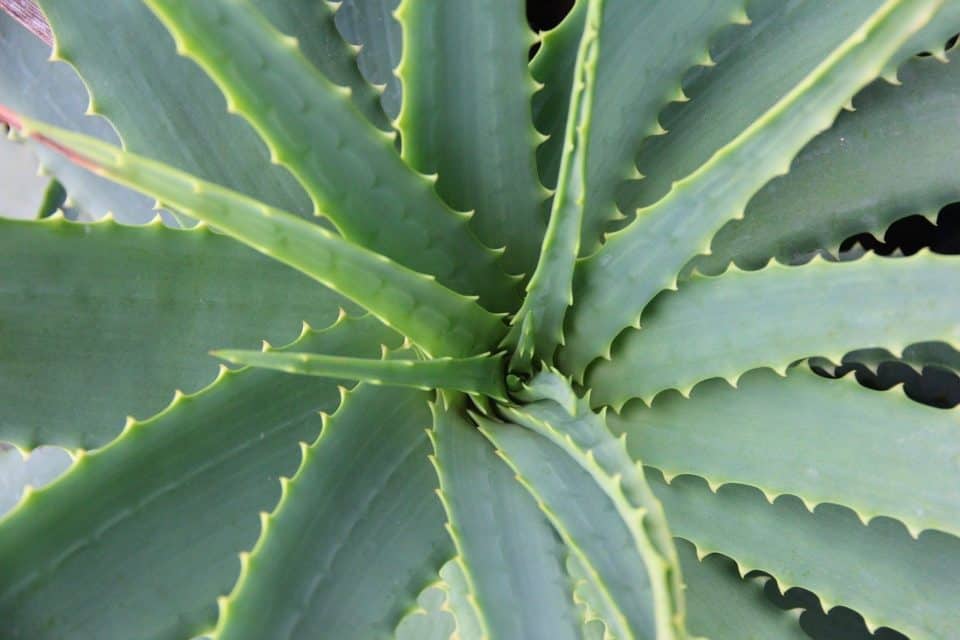Some links in the post are affiliate links and I get a commission from purchases made through some links found in the post.
Aloes of all types are quite sensitive to the conditions that we grow them in. If we do not provide them a suitable environment, they will react in different ways.
The ideal conditions for aloes are bright, sunny positions. They also do well in warmth. Now just because the aloe loves sunny places, this does not mean that it cannot do well indoors. It can, as long as it is in a light and bright place.
The aloe is not fussy about whether the light comes from the sun or is artificial as it will do well with either, so long as it is warm as well.
So why, you may ask, are my Aloe Vera Plant Leaves Bending?
Let’s look at the reasons for your aloe vera plant leaves bending.
Your aloe vera leaves are drooping due to not enough light, watering issues, fungal diseases, incorrect temperatures, soft roots and incorrect container sizes.
Providing your aloe vera with the correct care practices can restore it back from bending.
Check the Light Source
 Not enough light will cause your aloe vera to become leggy and grow towards the light. If this is a window on the left-hand side, you can expect to see a movement that way.
Not enough light will cause your aloe vera to become leggy and grow towards the light. If this is a window on the left-hand side, you can expect to see a movement that way.
Another clue about inadequate light will show up in your aloe vera as pale or white leaves. The converse of this is that exposure to strong and constant sunlight will bring out a reddish tint in the leaves.
Insufficient light will make the leaves weak and thin and eventually they will crease and bend.
The best option for this is simply to move your aloe vera to a better position. Select a warm, dry, and bright spot and leave the plant there for a few weeks. You will soon see if the spot is right, and the plant is happy.
Note: It is never a good idea to place an aloe vera in the bathroom as it will not do well with the high humidity combined with heat.
If your plant is struggling due to light, trying using this to help regulate the lighting.
Watering Issues
Drainage is of vital importance to the aloe vera if you keep it in a pot. Even if growing in the ground, good drainage is essential if your plant is to thrive.
When the water cannot drain away the plant inevitably suffers from root rot and cannot be saved.
If you need help watering your plant, try using this automatic drip irrigation kit.
Make sure that any containers have holes in the base for good drainage, and do not be tempted to overwater aloes. Underwatering them is not as damaging as overwatering as aloes can survive for some time with no water.
We have an article on what happens to an overwatered aloe vera plant.
Fungal Diseases
The external signs of a fungal disease appear as yellow and bending leaves. The plant will also look as if it is drying out. By the time you see that your plant is dried out, it may be too late to save it.
Aloes are susceptible to dry rot which will destroy the plant. Correct care, and watering, along with adequate light will keep dry rot at bay.
Note: If you transplant a plant with dry rot remember that the fungus will stay on the sides of the pot for a long time and can easily be passed on to another plant you place in it.
Temperature Incorrect
If you live in an area where the temperatures drop to around 10 degrees C (50 degrees F) your aloe vera will not do well and may start to droop its leaves. This will also happen if it is placed near cold air coming from open windows.
Ideally aloe vera does well in in temperature ranges of between 18-25 degrees C (64 – 77 degrees F).
Soft Rot
This is a bacterial disease which may make the leaves of your plant bend over. Soft rot spreads quickly and you will recognise it by the darker colour of the leaves. They may also become swollen with the gas which forms inside them.
Soft rot is mainly caused by overwatering the aloe, so check your watering routine and adjust it, particularly when the temperatures drop.
Incorrect Container Size
Small containers will cause your aloe vera to become pot bound. The roots of the plant need more space and cramping them may make the leaves droop.
To measure the size of the pot there should be about 2cm of space between the roots and the sides and base of the pot. If the roots are right up against the sides of the pot, the leaves will start to droop.
It is always better to place your aloe vera in a container which is slightly larger than it needs, than to have its’ roots cramped in a container which is too small.
How do I Stop my Aloe Vera Plant Leaves Bending?
The most likely cause of the aloe vera drooping its leaves are because the container is too small. This is an easy fix – you simply need to repot it in a bigger container.
Avoid shallow containers and opt for a sturdy deep pot which will give the roots plenty of space to develop.
If your aloe vera still droops you can try to stake it, or even separating it into smaller plants.
How to Stake Bending Aloe Vera Plant Leaves
 The most important thing to remember when staking your aloe vera is that you simply cannot use a shallow container. These plants need deep pots so that their roots can become established and support the leaves.
The most important thing to remember when staking your aloe vera is that you simply cannot use a shallow container. These plants need deep pots so that their roots can become established and support the leaves.
Additionally, if you place a stake in a shallow pot it will not be upright for very long.
Bamboo is a good example of what to use as a stake. Do not use iron bars as these can damage the root system.
Water the plant so that the soil around it is damp and gently insert the bamboo stakes around the drooping leaves. You should insert them about five inches away from the root ball.
Once you have inserted four stakes you will need to tie some twine around them so that the plant is encased inside the stakes.
If your plant is in a pot you should also turn the pot around so that the plant grows towards the source of light.
Should I Cut the Bent Aloe Vera Plant Leaves?
Once an aloe vera leaf has creased it will not increase or unbend. These are the best leaves to cut off and start new plants with. You can also use them for healing burns.
Because bent leaves look a trifle unsightly, you may want to cut them off and neaten up your plant.
Once you have cut off the bent leaves you may want to repot the plant in a deeper container.
Do you Water Aloe Vera from Top or Bottom?
You should always water your aloe vera from the bottom, instead of the top. Aim for the base of the plant instead of the little cup at the deep centre of the leaves.
Ideally your aloe vera prefers to be watered with rainwater or filtered water, although they will adapt to regular tap water. The rule of thumb here is that if you can drink the tap water, then so can your aloe vera – they will adapt!
It is best to pour the water around the edges of the container, rather than aiming for the middle of the plant. Water the plant deeply, and make sure that there is adequate drainage for excess water to run out.
Once the water starts to run out of the holes at the base of the container, you can stop watering.
Why not Water the Leaves Themselves?
As with most plants you should water the roots, not the leaves. Very few plants have the ability to absorb water through their leaves, most of the absorb it via the root system.
Aloe vera can grow to around 4’ in height so if you attempt to water the centre of the plant you risk damaging the leaves with the watering can.
While you may give our aloe a good slug of water on the leaves, you cannot be sure that any water has actually been absorbed. Better to water deeply when needed and to aim at the place where it can be absorbed best.
Final Thoughts
 Aloe vera plants are among the easiest plants to grow. Not only are they easy to propagate, but they also seldom suffer from diseases, which many other plants die from.
Aloe vera plants are among the easiest plants to grow. Not only are they easy to propagate, but they also seldom suffer from diseases, which many other plants die from.
They are easy to take care of and can grow in conditions that many other plants cannot. They are a great addition to any garden, and the pups can be re-potted and given as gifts.
Even a beginner gardener or someone who feels they do not have ‘green fingers’ can grow and aloe vera and be proud of the results.
Once you have found an ideal spot for them in your garden or in a pot, you can literally forget about them, water them every so often, take cuttings when you want to grow more, and leave them to get on with life!
With a little planning on where to place your aloe vera plant, and then a small amount of maintenance, there is no reason why you should not have more than one of these lovely plants in your garden.
Before you go, here are some more related articles I encourage you to read below to help solve more of your gardening issues:
Why Does My Aloe Plant Have No Roots
Why is my Aloe Vera Plant Turning Different Colors
Why is my Succulent Turning Purple

